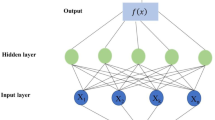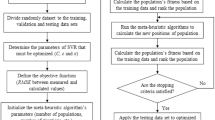Abstract
Precise estimation of aquifer hydraulic parameters can be an asset to more sustainable management of groundwater resources. The nonlinear correlation of aquifer parameters along with equation-level complicacy of aquifers’ charging functions can be efficiently handled using artificial intelligence models due to their flexibility in mapping between the observed data and output functions. This study focuses on performance comparisons for generalized regression neural network, artificial neural network (ANN) and adaptive neuro-fuzzy interference system (ANFIS) for estimation of hydraulic parameters, namely storage coefficient and transmissibility of confined aquifers. To acquire a greater precision of the estimated output functions, the principle component analysis of the pumping test data was initially undertaken to reduce the input dimensions by filtering out redundancies and insignificant variables’ correlations. Next, these data are passed into the training and validation process of the artificial intelligence models. Several error indices, mean absolute relative error (MARE), RMSE, MAE, RMRE, Bias and R2 were used during the validation of the prediction models. Finally, the estimated output functions were compared against the traditional and yet commonly used graphical Theis method. As an example, MARE in aquifer parameters estimation by ANN and graphical Theis method was 0.5564% and 1.1320%, respectively. More generally, among all the intelligence prediction models used to estimate the hydraulic parameters of a confined aquifer, ANFIS was more accurate and sensibly required much less computational time than the others and, hence, may be selected as the superior model in aquifer parameters estimation.






Similar content being viewed by others
References
Abdi H, Williams LJ (2010) Principal component analysis. Wiley Interdiscip Rev Comput Stat 2:433–459
Abraham A (2005) Adaptation of fuzzy inference system using neural learning. In: Nedjah N, Macedo Mourelle L (eds) Fuzzy systems engineering. Springer, Berlin, pp 53–83
Azari T, Samani N, Mansoori E (2015) An artificial neural network model for the determination of leaky confined aquifer parameters: an accurate alternative to type curve matching methods. Iran J Sci Technol 39:463
Balkhair KS (2002) Aquifer parameters determination for large diameter wells using neural network approach. J Hydrol 265:118–128
Basheer I, Hajmeer M (2000) Artificial neural networks: fundamentals, computing, design, and application. J Microbiol Methods 43:3–31
Baum EB, Haussler D (1989) What size net gives valid generalization? Neural Comput 1:151–160
Bro R, Smilde AK (2014) Principal component analysis. Anal Methods 6:2812–2831
Carrera J, Neuman SP (1986) Estimation of aquifer parameters under transient and steady state conditions: 1. Maximum likelihood method incorporating prior information. Water Resour Res 22:199–210
Ch S, Mathur S (2012) Particle swarm optimization trained neural network for aquifer parameter estimation. KSCE J Civ Eng 16:298–307
Chang FJ, Chang Y-T (2006) Adaptive neuro-fuzzy inference system for prediction of water level in reservoir. Adv Water Resour 29:1–10
Chen S, Cowan CF, Grant PM (1991) Orthogonal least squares learning algorithm for radial basis function networks. IEEE Trans Neural Netw 2:302–309
Cigizoglu HK (2003) Estimation, forecasting and extrapolation of river flows by artificial neural networks. Hydrol Sci J 48:349–361
Cigizoglu HK, Alp M (2006) Generalized regression neural network in modelling river sediment yield. Adv Eng Softw 37:63–68
Coppola E Jr, Poulton M, Charles E, Dustman J, Szidarovszky F (2003) Application of artificial neural networks to complex groundwater management problems. Nat Resour Res 12:303–320
Dayhoff JE (1990) Neural network architectures: an introduction. Van Nostrand Reinhold Co, New York
Denai MA, Palis F, Zeghbib A (2004) ANFIS based modelling and control of non-linear systems: a tutorial. In: 2004 IEEE international conference on systems, man and cybernetics. IEEE, pp 3433–3438
Dibike YB, Solomatine DP (2001) River flow forecasting using artificial neural networks. Phys Chem Earth B 26:1–7
Dowla FU, Rogers LL (1995) Solving problems in environmental engineering and geosciences with artificial neural networks. MIT Press, Cambridge
Firat M, Güngör M (2007) River flow estimation using adaptive neuro fuzzy inference system. Math Comput Simul 75:87–96
Gaur S, Ch S, Graillot D, Chahar BR, Kumar DN (2013) Application of artificial neural networks and particle swarm optimization for the management of groundwater resources. Water Resour Manag 27:927–941
Ghomsheh VS, Shoorehdeli MA, Teshnehlab M (2007) Training ANFIS structure with modified PSO algorithm. In: 2007 MED’07 mediterranean conference on control and automation. IEEE, pp 1–6
Goh A (1995) Back-propagation neural networks for modeling complex systems. Artif Intell Eng 9:143–151
Gohari-Moghadam M, Samani N, Sleep B (2009) Aquifer parameter determination using a neuro-fuzzy approach. Paper presented at the international conference on water resources: emphasis on regional development. Shahrood University of Technology
Hagan MT, Demuth HB, Beale MH, De Jesús O (1996) Neural network design. PWS publishing company, Boston
Haydari Z, Kavehnia F, Askari M, Ganbariyan M (2007) Time-series load modelling and load forecasting using neuro-fuzzy techniques. In: 2007 9th international conference on electrical power quality and utilisation. IEEE, pp 1–6
Haykin S (1994) Neural networks: a comprehensive foundation. Macmillan College Publishing Company, New York
Jang JSR (1991) Fuzzy modeling using generalized neural networks and Kalman filter algorithm. AAAI, pp 762–767
Jang JS (1993) ANFIS: adaptive-network-based fuzzy inference system. IEEE Trans Syst Man Cybern 23:665–685
Jolliffe I (2002) Principal component analysis. Wiley Online Library, Hoboken
Karahan H, Ayvaz MT (2008) Simultaneous parameter identification of a heterogeneous aquifer system using artificial neural networks. Hydrogeol J 16:817–827
Kumari N, Pathak G, Prakash O (2016) A review of application of artificial neural network in ground water modeling. In: Sinha AK, Rajesh R, Ranjan P, Singh RP (eds) Recent advances in mathematics, statistics and computer science. World Scientific Pub Co Inc., pp 393–402
Li HZ, Guo S, Li CJ, Sun JQ (2013) A hybrid annual power load forecasting model based on generalized regression neural network with fruit fly optimization algorithm. Knowl-Based Syst 37:378–387
Lin GF, Chen GR (2006) An improved neural network approach to the determination of aquifer parameters. J Hydrol 316:281–289
Lin HT, Tan YC, Chen CH, Yu HL, Wu SC, Ke KY (2010a) Estimation of effective hydrogeological parameters in heterogeneous and anisotropic aquifers. J Hydrol 389:57–68
Lin HT, Ke KY, Chen CH, Wu SC, Tan YC (2010b) Estimating anisotropic aquifer parameters by artificial neural networks. Hydrol Process 24:3237–3250
Maiti S, Tiwari R (2014) A comparative study of artificial neural networks, Bayesian neural networks and adaptive neuro-fuzzy inference system in groundwater level prediction. Environ Earth Sci 71:3147–3160
Negnevitsky M (2005) Artificial intelligence: a guide to intelligent systems. Pearson Education, London
Pan L, Wu L (1998) A hybrid global optimization method for inverse estimation of hydraulic parameters: annealing-simplex method. Water Resour Res 34:2261–2269
Polat K, Güneş S (2007) An expert system approach based on principal component analysis and adaptive neuro-fuzzy inference system to diagnosis of diabetes disease. Digit Signal Process 17:702–710
Rafiq M, Bugmann G, Easterbrook D (2001) Neural network design for engineering applications. Comput Struct 79:1541–1552
Rajesh M, Kashyap D, Hari Prasad K (2010) Estimation of unconfined aquifer parameters by genetic algorithms. Hydrol Sci J 55:403–413
Razavi S, Tolson BA (2011) A new formulation for feedforward neural networks. IEEE Trans Neural Netw 22:1588–1598
Sahin AU (2016) A new parameter estimation procedure for pumping test analysis using a radial basis function collocation method. Environ Earth Sci 75:1–13
Samani N, Gohari-Moghadam M, Safavi A (2007) A simple neural network model for the determination of aquifer parameters. J Hydrol 340:1–11
Samuel MP, Jha MK (2003) Estimation of aquifer parameters from pumping test data by genetic algorithm optimization technique. J Irrig drain Eng ASCE 129:348–359
Sawyer CS, Achenie LE, Lieuallen KK (1995) Estimation of aquifer hydraulic conductivities: a neural network approach. IAHS Publ Ser Proc Rep-Intern Assoc Hydrol Sci 227:177–184
Shlens J (2014) A tutorial on principal component analysis. arXiv preprint arXiv:14041100
Takagi T, Sugeno M (1985) Fuzzy identification of systems and its applications to modeling and control. IEEE Trans Syst Man Cybern SMC-15(1):116–132
Todd DK, Mays LW (2005) Groundwater hydrology. Wiley, Hoboken
Walton WC (1960) Leaky artesian aquifer conditions in Illinois. Report of investigation 39. State of Illinois, Department of Registration and Education, Illinois State Water Survey, Urbana
Wang Y-M, Elhag TM (2008) An adaptive neuro-fuzzy inference system for bridge risk assessment. Expert Syst Appl 34:3099–3106
Wold S, Esbensen K, Geladi P (1987) Principal component analysis. Chemom Intell Lab Syst 2:37–52
Yun Z, Quan Z, Caixin S, Shaolan L, Yuming L, Yang S (2008) RBF neural network and ANFIS-based short-term load forecasting approach in real-time price environment. IEEE Trans Power Syst 23:853–858
Zare M, Pourghasemi HR, Vafakhah M, Pradhan B (2013) Landslide susceptibility mapping at Vaz Watershed (Iran) using an artificial neural network model: a comparison between multilayer perceptron (MLP) and radial basic function (RBF) algorithms. Arab J Geosci 6:2873–2888
Author information
Authors and Affiliations
Corresponding author
Ethics declarations
Conflict of interest
Authors declare that they have no conflict of interest in this research.
Rights and permissions
About this article
Cite this article
Delnaz, A., Rakhshandehroo, G. & Nikoo, M.R. Confined Aquifer’s Hydraulic Parameters Estimation by a Generalized Regression Neural Network. Iran J Sci Technol Trans Civ Eng 44, 259–269 (2020). https://doi.org/10.1007/s40996-019-00238-2
Received:
Accepted:
Published:
Issue Date:
DOI: https://doi.org/10.1007/s40996-019-00238-2




